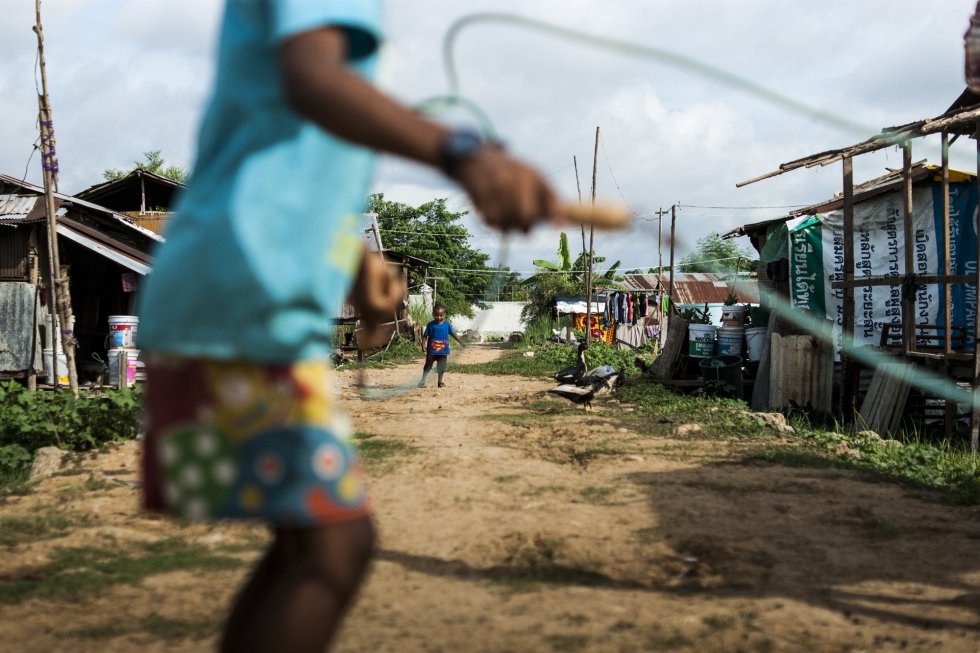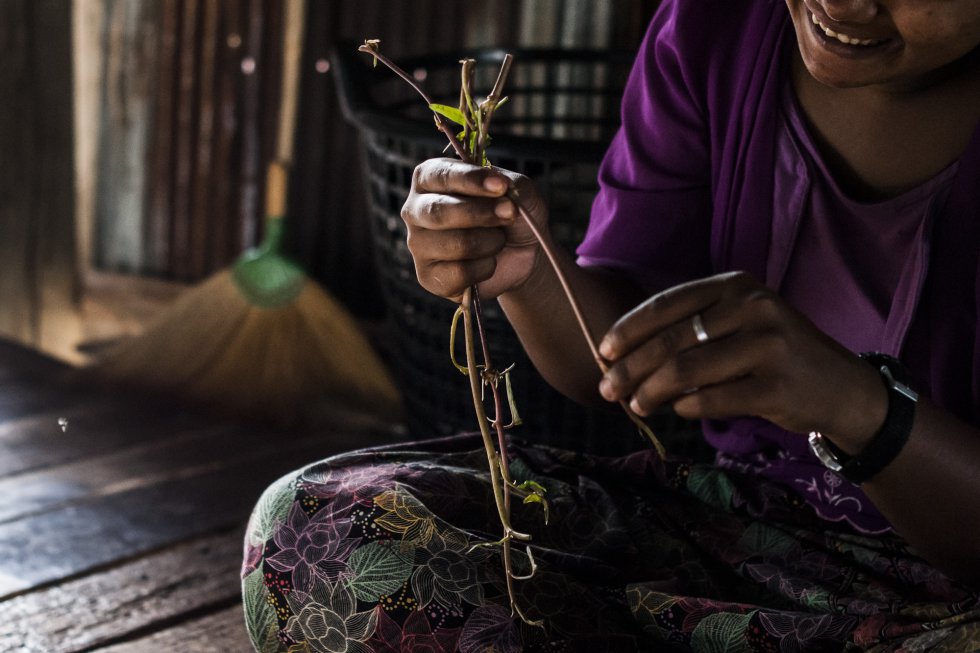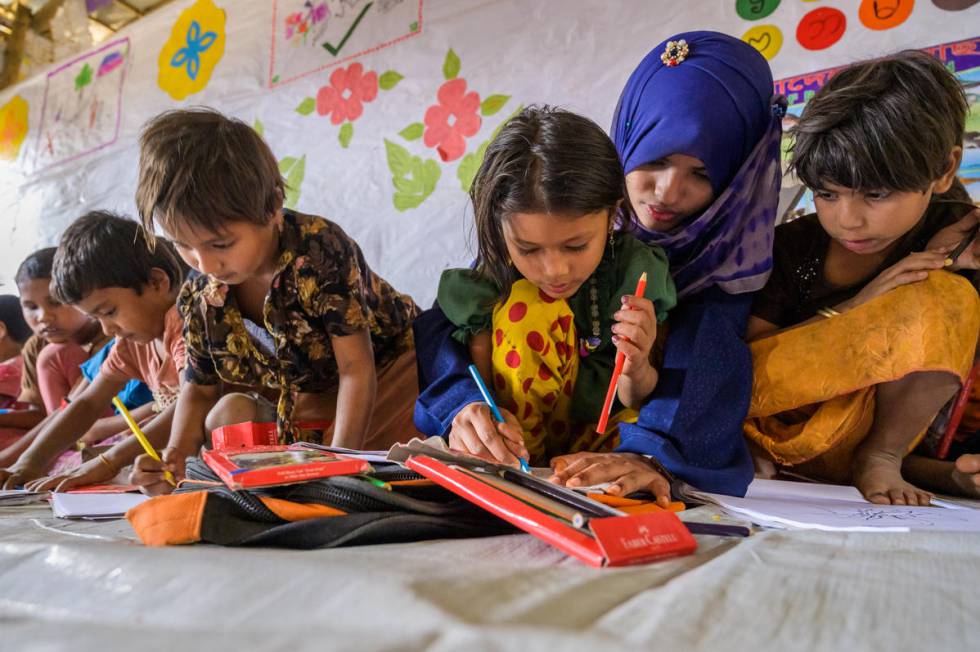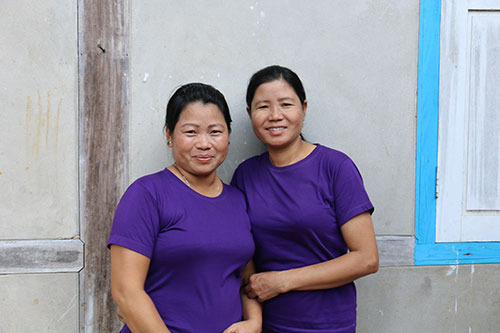Asia/Noviembre 2020/elpais.com
La vida de Sandar es la de miles de mujeres víctimas de malos tratos, que durante la pandemia se han intensificado. Ella, además, es inmigrante irregular, lo que impide que reciba más ayuda, y el estigma social en una cultura conservadora, la ata a su maltratador
-

1Sandar (nombre ficticio) tiene 28 años. Es una emigrante birmana sin documentación que vive en Mae Sot, en la frontera entre Tailandia y Myanmar. Lleva 11 años en una relación de maltrato. Su marido le pega y abusa sexualmente de ella. La situación familiar empeoró desde el brote de covid-19. Como su marido se quedó sin trabajo, discutían constantemente por el dinero. Sandar es una de los aproximadamente 200.000 emigrantes birmanos que viven en la región de Mae Sot. Muchos de ellos carecen de documentación y trabajan en condiciones precarias. Desde que estalló la pandemia no tienen trabajo ni apoyo del Gobierno tailandés, y tampoco la posibilidad de volver a Myanmar debido al cierre de las fronteras. Según cálculos de ONU Mujeres, en algunos países los casos de violencia doméstica han aumentado un 30%. La organización califica el fenómeno de «pandemia en la sombra». -

2Una vista del barrio donde vive Sandar, en las afueras de Mae Sot. Sandar procede de Mawlamiyaing, una ciudad birmana situada a 130 kilómetros de Mae Sot. La joven entró ilegalmente en Tailandia cuando tenía 15 años. La larga frontera de la zona de Mae Sot, en la que los dos países están separados solamente por un río, la convierte en el lugar perfecto para que los birmanos entren ilegalmente en Tailandia. En los últimos tiempos, las autoridades tailandesas han intensificado los controles fronterizos debido al aumento del número de casos de covid-19 en Myanmar. Mae Sot es una zona principalmente rural. Muchos emigrantes birmanos están empleados en la agricultura, y a menudo cobran menos del salario mínimo. Con ocasión del Día Internacional de la Mujer Rural el pasado 15 de octubre, ONU Mujeres subrayó este año «la urgente necesidad de fomentar la capacidad de resistencia de las mujeres rurales tras la covid-19 reforzando su bienestar y unos medios de vida sostenibles con el fin de ‘reconstruir mejor». -

3Los hijos de Sandar, de nueve y tres años, juegan en la calle delante de su casa. Sandar ha sufrido toda su vida malos tratos en el ámbito familiar. Su tía, que la alojó a su llegada a Tailandia, le pegaba continuamente. «Me golpeaba con cables», cuenta la joven, que nunca fue al hospital ni llamó a la policía. «No sabía a dónde ir. No hablaba tailandés. Además, mi tía me encerraba en casa, así que no podía salir». Sandar se casó a los dos años de llegar a Tailandia. Tenía 17. Según la ONU, menos del 40% de las mujeres víctimas de violencia física en el ámbito doméstico busca ayuda. 
4 El hijo mayor de Sandar juega con un arma de juguete. Sandar recuerda que su marido empezó a maltratarla nada más casarse. «Me pegaba y me daba patadas cuando volvía del trabajo», cuenta. «Me acusaba de que no cocinaba o no limpiaba». A raíz de la llegada de la covid-19, el hombre se volvió más violento, «sobre todo por el dinero». Antes de la pandemia tampoco había tenido trabajo fijo, pero durante el cierre perdió su empleo en una huevería. Las emigrantes birmanas en Tailandia ya formaban un grupo de alto riesgo antes de la covid-19, pero con la pandemia su vida se ha vuelto más difícil. Durante el confinamiento, las víctimas de violencia doméstica se encontraron encerradas en casa con su maltratador, con menos posibilidades de pedir ayuda, y escasos o ningún ingreso. ![El hijo pequeño de Sandar juega con un arma de juguete disfrazado de Supermán. En 2018, Sandar buscó ayuda por primera vez y se puso en contacto con las trabajadoras del Freedom Restoration Project [Proyecto Restauración de la Libertad], que ofrece refugio y apoyo a las víctimas de violencia doméstica en la región de Mae Sot. Gracias a su ayuda, varias mujeres consiguieron escapar de su situación de maltrato. Otras, como Sandar, mantienen la relación con su maltratador, pero en el centro han encontrado un espacio en el que están a salvo, al menos durante unas horas. "Las mujeres que vienen al centro son víctimas de violencia física, psicológica y sexual", explica Watcharapon 'Sia' Kukaewkasem, fundadora y directora del proyecto. "En Tailandia y en Myanmar la violencia doméstica es muy habitual. Tanto que la gente la considera normal".](https://ep00.epimg.net/elpais/imagenes/2020/10/26/album/1603717461_363685_1603718215_album_normal.jpg)
5El hijo pequeño de Sandar juega con un arma de juguete disfrazado de Supermán. En 2018, Sandar buscó ayuda por primera vez y se puso en contacto con las trabajadoras del Freedom Restoration Project [Proyecto Restauración de la Libertad], que ofrece refugio y apoyo a las víctimas de violencia doméstica en la región de Mae Sot. Gracias a su ayuda, varias mujeres consiguieron escapar de su situación de maltrato. Otras, como Sandar, mantienen la relación con su maltratador, pero en el centro han encontrado un espacio en el que están a salvo, al menos durante unas horas. «Las mujeres que vienen al centro son víctimas de violencia física, psicológica y sexual», explica Watcharapon ‘Sia’ Kukaewkasem, fundadora y directora del proyecto. «En Tailandia y en Myanmar la violencia doméstica es muy habitual. Tanto que la gente la considera normal». 
6Sandar se pinta los labios antes de salir hacia el centro de detención de Mae Sot a visitar a su marido, detenido hace poco por posesión de drogas. Es la tercera vez que lo detienen. Las dos primeras fueron por consumo de drogas, pero en esta ocasión la policía le encontró varias pastillas de yaba. También conocido como «la droga de la locura», el yaba es una combinación de metanfetamina y otros estimulantes muy popular en el sudeste de Asia. Ahora que su marido está encerrado, Sandar tiene que encontrar un trabajo para alimentar a sus dos hijos. «Cuando está fuera, no quiere que trabaje», explica. Mientras su marido está detenido, ella trabaja como limpiadora o vendiendo verdura en la calle, pero no gana lo suficiente ni recibe ayuda del Gobierno tailandés. «¿Quién va a ayudarnos?», se lamenta. «No tenemos documentos». ONU Mujeres calcula que las mujeres que trabajan en la economía sumergida en Tailandia verán reducidos sus ingresos en un 80% debido a la crisis de la covid-19. 
7Una vista de la calle desde la casa de Sandar, en las afueras de Mae Sot. En Tailandia existe una línea telefónica para denunciar la violencia doméstica. Sin embargo, hace cinco años el Gobierno pasó de destinarla a los casos de violencia contra las mujeres y los niños (así como a los de tráfico de personas, trabajo infantil y embarazo adolescente) a cualquier problema social, como señala un informe de la Fundación Henrich Böll. Según ese mismo estudio, durante el cierre de marzo y abril, el teléfono de asistencia recibió una avalancha de más de 28.000 llamadas, más del doble que en el mismo periodo del año anterior. La mayoría, sin embargo, eran quejas o consultas sobre la asistencia social y las ayudas económicas del Gobierno. Eso hizo aún más difícil para las víctimas de violencia doméstica acceder a la línea. 
8Sandar lava verduras en su casa antes de cocinarlas. Tiene que preparar la comida para su marido y llevársela al centro de detención. Confiesa que se siente incapaz de divorciarse. Teme la estigmatización social, que en una comunidad musulmana conservadora puede ser fuerte. «Pienso en mis hijos», se justifica. «A lo mejor, después de dejarlo tendría otro marido. Entonces la gente diría que tengo dos maridos y que los niños deberían estar con su madre y con su padre». Según un informe de la Fundación Heinrich Böll, en Tailandia las actitudes sociales constituyen un obstáculo importante para que las mujeres denuncien la violencia. Como en muchos países del mundo, a menudo la violencia doméstica se considera un asunto privado y es habitual pensar que la culpa es de la víctima, y no del maltratador. Para algunas mujeres, reconocer el maltrato equivale a reconocer que han fracasado en su matrimonio. 
9 Sandar monta en bicicleta con su hijo pequeño disfrazado de Superman. Se dirigen al centro de detención de Mae Sot a visitar al marido apresado por posesión de drogas. 
10Sandar pone ‘thanaka’ a su hijo menor en la cara antes de salir. El ‘thanaka’ es una pasta cosmética de color blanco amarillento hecha a base de corteza molida que las mujeres birmanas suelen emplear para suavizar la piel y protegerla del sol. ![El hijo mayor de Sandar, de nueve años, corre por un campo cercano a su casa, en las afueras de Mae Sot. El niño se queda en casa mientras su madre y su hermano menor van al centro de detención. El Proyecto Restauración de la Libertad organiza clases de crianza para enseñar métodos educativos alternativos a las víctimas de violencia doméstica. "Les enseñamos que hay otras maneras [de educar a los hijos] que no son gritar y pegar", explica Watcharapon 'Sia' Kukaewkasem, fundadora y directora del proyecto. "Cuando hablamos de violencia doméstica no nos referimos solo a la que ejerce la pareja, sino también a la de los padres contra los hijos. [...] Intentamos prevenirla".](https://ep00.epimg.net/elpais/imagenes/2020/10/26/album/1603717461_363685_1603718512_album_normal.jpg)
11El hijo mayor de Sandar, de nueve años, corre por un campo cercano a su casa, en las afueras de Mae Sot. El niño se queda en casa mientras su madre y su hermano menor van al centro de detención. El Proyecto Restauración de la Libertad organiza clases de crianza para enseñar métodos educativos alternativos a las víctimas de violencia doméstica. «Les enseñamos que hay otras maneras [de educar a los hijos] que no son gritar y pegar», explica Watcharapon ‘Sia’ Kukaewkasem, fundadora y directora del proyecto. «Cuando hablamos de violencia doméstica no nos referimos solo a la que ejerce la pareja, sino también a la de los padres contra los hijos. […] Intentamos prevenirla» 
12El hijo pequeño de Sandar, de tres años, espera a su madre sentado en la bicicleta vestido con un traje de Superman. Van al centro de detención de Mae Sot a visitar a su padre. «Me gustaría que mis hijos no tuviesen que trabajar tanto como yo», dice Sandar. «Me gustaría que estudiasen y fuesen médicos o contables». Fuente e imagen tomadas de: https://elpais.com/elpais/2020/10/26/album/1603717461_363685.html#foto_gal_7
















 Users Today : 35
Users Today : 35 Total Users : 35460052
Total Users : 35460052 Views Today : 50
Views Today : 50 Total views : 3418681
Total views : 3418681